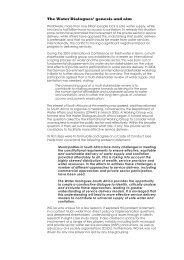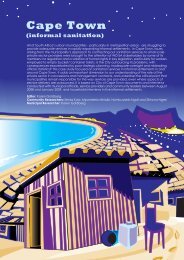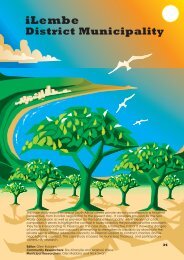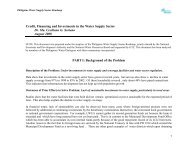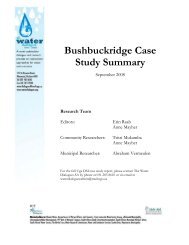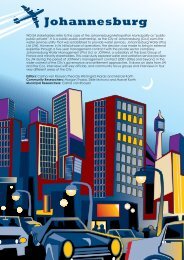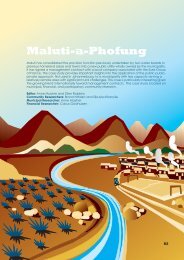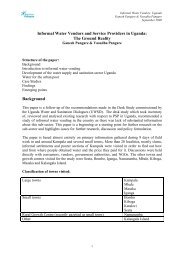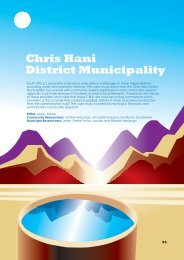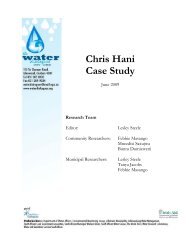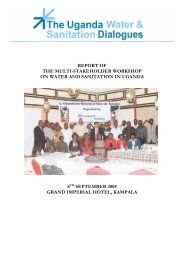Ugu Case Study Summary - The Water Dialogues
Ugu Case Study Summary - The Water Dialogues
Ugu Case Study Summary - The Water Dialogues
You also want an ePaper? Increase the reach of your titles
YUMPU automatically turns print PDFs into web optimized ePapers that Google loves.
Finding 2: <strong>The</strong>re are still massive backlogs, though they are not spread<br />
evenly across the district municipalities: urban coastal areas receive<br />
better services than inland rural communities.<br />
<strong>The</strong> municipality is performing well, relative to other district municipalities, but substantial<br />
investments are required to provide effective, equitable and affordable water and sanitation.<br />
While <strong>Ugu</strong> is making progress in the inland areas, the backlogs are still considerable and the<br />
difference in level of services between urban and rural areas is quite marked:<br />
Around 40 percent of the population still does not have access to potable water, which<br />
means about 263,000 <strong>Ugu</strong> residents are living without access to safe water:<br />
99.4 percent of urban residents and 35 percent of rural households have access to<br />
water at a Reconstruction and Development Programme (RDP) standard of a<br />
standpipe within 200 metres;<br />
Informal settlements outside of established urban areas are not counted in the 16<br />
percent of residents who reside in urban areas. Residents in these areas make up<br />
about two percent of the population and are mostly served by standpipes, and<br />
some from natural sources; and<br />
In the communities where the research was conducted, most residents obtained<br />
their water from standpipes or rivers. <strong>The</strong> majority of people in the four communities<br />
do not have metered connections or pay for their water.<br />
Delivery of sanitation services parallels that of water in terms of the urban/rural divide, but<br />
both the number of backlogs and the difference between levels of service are greater:<br />
70 percent of the population does not have access to basic sanitation;<br />
6<br />
Around 14 percent of households have waterborne sewage systems. <strong>The</strong>se are<br />
almost exclusively in urban areas. <strong>The</strong> access and level of sanitation services in rural<br />
areas are still very low, but some communities have begun to receive Ventilated<br />
Improved Pit latrines (VIPs);<br />
All of the research communities had some form of municipal sanitation, but the<br />
quantity and quality was often inadequate, and a number of households in all of<br />
the areas were still using toilets they had constructed themselves.<br />
Finding 3: <strong>Ugu</strong> struggles to secure adequate funding to eradicate<br />
backlogs in water and sanitation provision, despite being fairly highly<br />
capacitated and applying for grants.<br />
<strong>Ugu</strong> DM is a large, well-established municipality, with a good-sized operating expenditure (OPEX)<br />
budget, but the municipality contends the main reason for the remaining backlogs in both<br />
urban and rural areas is insufficient funding to effectively address the backlogs:<br />
<strong>The</strong> estimated cost of eradicating water backlogs is R1.12 billion. <strong>The</strong> cost could potentially<br />
be higher due to lack of readily available natural sources of water, and areas with low<br />
7<br />
population densities or dispersed settlement patterns.<br />
<strong>The</strong> backlogs in sanitation are even greater. <strong>The</strong> estimated cost of providing a VIP for each<br />
family across <strong>Ugu</strong> DM is estimated to be R280 million. In high-density urban areas, improvement<br />
8<br />
of water-borne sewerage comes at an even greater per-capita cost.<br />
Officials estimate that <strong>Ugu</strong> has sufficient staff capacity to efficiently spend about double the<br />
amount of funds it has currently been allocated, which they predict would greatly accelerate<br />
the expansion of basic services coverage<br />
Finding 4: From most official reports, it appears that <strong>Ugu</strong>’s financial<br />
management is sound.<br />
SALGA’s National Benchmarking Initiative Report, 2007 shows the following:<br />
Cash collection efficiency is between 90 and 100 percent, and water services provider<br />
9<br />
billing is 99.9 percent accurate. Internal accounting techniques appear to play a role in<br />
the high payment rates. Despite the unrestricted access communities have to water from<br />
standpipes, the accounting department considers the municipality to be “billing everyone”.<br />
THE WATER DIALOGUES SYNTHESIS REPORT 2009-<strong>Ugu</strong> <strong>Case</strong> <strong>Study</strong><br />
122



